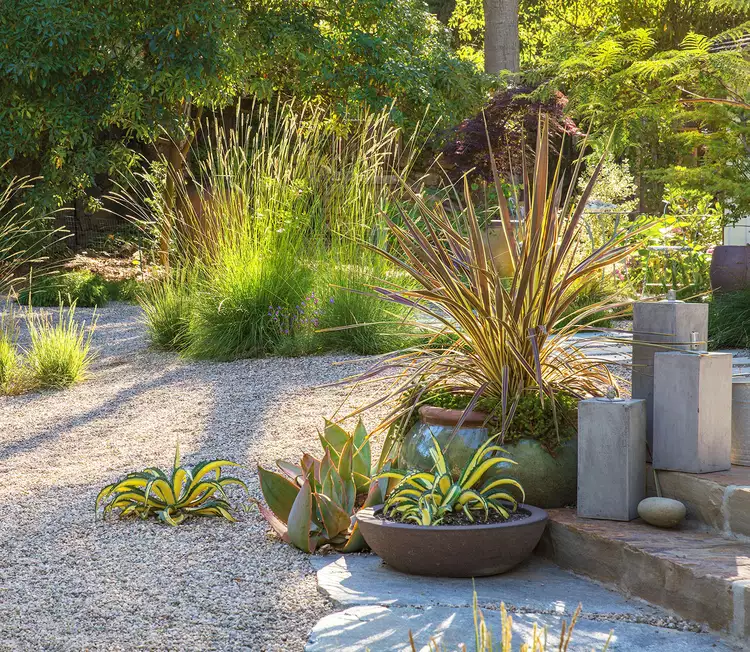Green grass with a picket fence is often considered the picture-perfect ideal for a yard, but a lawn isn't necessarily the best choice for every climate or home. Grass alternatives are gaining popularity because turf grass requires a lot of effort to keep it looking lush. More often than not, lawns get patchy and dry during warm seasons and discolored during others without a lot of watering. They need regular mowing to keep them looking tidy.
If maintenance also involves using pesticides and synthetic fertilizers, these chemicals can harm people and the environment. Instead, consider these four grass alternatives experts say can offer plenty of curb appeal with less maintenance.
"Grass-free lawns are an emerging trend in the U.S., having started in the western states and moving toward the East Coast. We're seeing more homeowners choosing to reduce the size of their lawn and plant edible landscapes, pollinator gardens, rainwater gardens, and native prairies/wildflowers, as opposed to grass. This dramatically reduces water usage and allows you to use fewer chemicals and resources—goodbye, lawnmower," says Joe Raboine, Director of Residential Hardscapes at Belgard.
The ideal option truly depends on what you'd rather do outdoors instead of cutting and watering the lawn. For example, Haeley Giambalvo, the native plant enthusiast behind NativeBackyards.com, has spent the last three years transforming her yard with native plants to become a pollinator and wildlife haven. Raboine and Giambalvo share their insights to help you take the guesswork out of choosing between all the current lawn alternatives.
1. Go for Gravel
For those not interested in doing any lawn or plant maintenance, decorative gravel is a popular alternative, says Raboine. "There are a multitude of choices for scale and color, so you can match any style," he adds. Landscape gravel or pebbles come in different washes and colors. You can easily blend in with the natural outdoor decor by matching rock to local formations. This versatile and affordable grass alternative works well in rainy weather and near bodies of water such as creeks and ponds.
2. Try Artificial Turf
Artificial turf offers several appealing features that make it an excellent grass alternative. Like carpeting for your home, "it comes in a variety of pile heights and styles, and it can last for decades when installed correctly. There are even turf options today designed for dogs and that can minimize bacteria and cleanup," says Raboine.
These synthetic fibers look like grass, but they aren't. The fibers themselves come in different blade shapes, like oval, diamond, W, and V formations. Artificial turf is durable, making it perfect for an outdoor football or soccer game. And it's breathable with perforated holes on the bottom so that water drains before mold or bacteria can grow. With just periodic cleaning, artificial turf is a grass alternative that can give you the look of a lush green lawn without any of the toil of regular grass.
3. Plant Low-Maintenance Groundcovers
A groundcover can be just about any low-growing plant, but the best ones to use as a lawn alternative can tolerate being stepped on. One of Giambalvo's favorite choices is turkey tangle fogfruit (Phyla nodiflora). Also called matgrass and carpetweed, these colorful names hint at what it looks like. This plant grows quickly in sunny areas, reaching 3-12 inches tall, and needs much less water than traditional grass. Fogfruit is hardy in Zones 7-11 and is evergreen in warmer southern climates. "This pretty groundcover is native to 23 states and is covered with tiny white and purple flowers that pollinators love," Giambalvo says.
4. Build a Bed
For people who don't want to replace their grass entirely but would like to reduce their lawn, the best alternative might be to make a bed. A flower bed can be used for "beautiful flowering plants and shrubs that are native to your local area," suggests Giambalvo. "These plants have evolved in the local climate and tend to be very hardy and drought tolerant. They need little supplemental water once established. A native garden not only saves on water costs, it also will attract a variety of pollinators and birds to your yard." Also, if you're curious about growing food, a raised bed can be used for an herb or vegetable garden.
Grass Alternative Considerations
There are a lot of grass alternatives for yards to choose from. So whether you're eyeing permeable pavers or green leafy vegetables, there are a few things to remember.
Water sources and weather around your home are essential factors to consider. For example, if your current lawn absorbs a lot of runoff from rain or overflow, consider how your new landscape will do the same. Make sure that materials allow proper drainage to continue and that any planting is done far enough away from your home so that water and roots don't damage the house's foundation.
Also, be prepared that natural grass alternatives—edible or not—will attract insects and other critters you don't typically see on grass. Embrace the change by adding native plants and bird feeders to the yard to further enhance your little wildlife habitat.
Last, before making significant changes, verify that your landscaping plans are permitted in your area. Homeowners associations and local ordinances may restrict vegetation height or percentage of grass on the property. Avoid fines and upset neighbors by checking the rules beforehand.




















